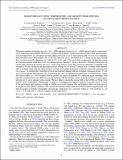SIGNATURES OF CLOUD, TEMPERATURE, AND GRAVITY FROM SPECTRA OF THE CLOSEST BROWN DWARFS
Author(s)
Faherty, Jacqueline K.; Beletsky, Yuri; Burgasser, Adam J.; Tinney, Chris; Osip, David J.; Filippazzo, Joseph C.; Simcoe, Robert A.; ... Show more Show less
DownloadFaherty-2014-Signatures of cloud.pdf (1.841Mb)
PUBLISHER_POLICY
Publisher Policy
Article is made available in accordance with the publisher's policy and may be subject to US copyright law. Please refer to the publisher's site for terms of use.
Terms of use
Metadata
Show full item recordAbstract
We present medium-resolution optical (λ/Δλ ~ 4000) and near-infrared (λ/Δλ ~ 8000) spectral data for components of the newly discovered WISE J104915.57-531906.1AB (Luhman 16AB) brown dwarf binary. The optical spectra reveal strong 6708 Å Li I absorption in both Luhman 16A (8.0 ± 0.4 Å) and Luhman 16B (3.8 ± 0.4 Å) confirming their substellar mass. Interestingly, this is the first detection of Li I absorption in a T dwarf. In the near-infrared data, we find strong K I absorption at 1.168, 1.177, 1.243, and 1.254 μm in both components. Neither the optical nor the near-infrared alkali lines show low surface gravity signatures. Along with the Li I absorption detection, we can broadly constrain the system age to 0.1-3 Gyr or the mass to 20-65 M [subscript Jup] for each component. Compared to the strength of K I line absorption in equivalent spectral subtype brown dwarfs, Luhman 16A is weaker while Luhman 16B is stronger. Analyzing the spectral region around each doublet in distance scaled flux units and comparing the two sources, we confirm the J-band flux reversal and find that Luhman 16B has a brighter continuum in the 1.17 μm and 1.25 μm regions than Luhman 16A. Converting flux units to a brightness temperature we interpret this to mean that the secondary is ~50 K warmer than the primary in regions dominated by condensate grain scattering. One plausible explanation for this difference is that Luhman 16B has thinner clouds or patchy holes in its atmosphere allowing us to see to deeper, hotter regions. We also detect comparably strong FeH in the 0.9896 μm Wing-Ford band for both components. Traditionally, a signpost of changing atmosphere conditions from late-type L to early T, the persistence and similarity of FeH at 0.9896 μm in both Luhman 16A and Luhman 16B is an indication of homogenous atmosphere conditions. We calculate bolometric luminosities from observed data supplemented with best fit models for longer wavelengths and find the components are consistent within 1σ with resultant T [subscript effs] of 1310 ± 30 K and 1280 ± 75 K for Luhman 16AB respectively.
Date issued
2014-08Department
Massachusetts Institute of Technology. Department of Physics; MIT Kavli Institute for Astrophysics and Space ResearchJournal
Astrophysical Journal
Publisher
Institute of Physics/American Astronomical Society
Citation
Faherty, Jacqueline K., Yuri Beletsky, Adam J. Burgasser, Chris Tinney, David J. Osip, Joseph C. Filippazzo, and Robert A. Simcoe. “SIGNATURES OF CLOUD, TEMPERATURE, AND GRAVITY FROM SPECTRA OF THE CLOSEST BROWN DWARFS.” The Astrophysical Journal 790, no. 2 (July 8, 2014): 90.© 2014 American Astronomical Society.
Version: Final published version
ISSN
0004-637X
1538-4357